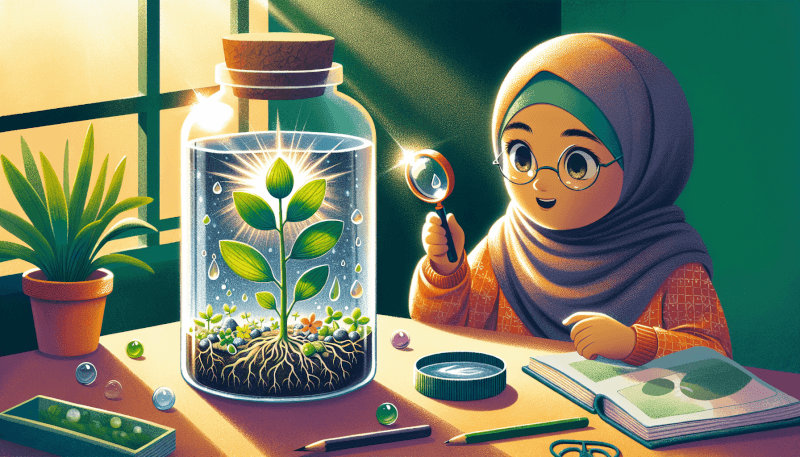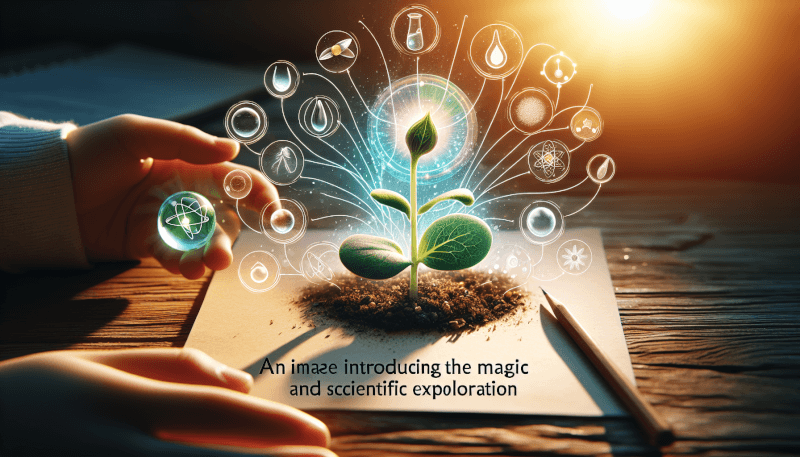👋 Click the mic button to talk to Alfred, the Todd's Seeds Gardening/Sprouting Expert – Feel free to ask him anything!
Ask Virtual Todd Anything - Click the Mic
In this captivating article, you will embark on a fascinating journey into the world of sprouting seeds. This hands-on experiment will allow you to witness the remarkable process of growth and explore the factors that contribute to the success of sprouting seeds. Get ready to discover the wonder of nature as you observe tiny seeds blossom into vibrant plants right before your eyes. So grab your gardening gloves and get ready to dig into the sprouting seeds experiment!
Materials Required
To conduct this sprouting seeds experiment, you will need the following materials:
Seeds
You will need a variety of different seeds, such as flower seeds or vegetable seeds. By choosing different types of seeds, you can observe how various plants germinate and grow.
Containers
Prepare containers for planting the seeds. Using separate containers for each type of seed will help you easily compare their growth. You can use small pots, cups, or even recycled containers.
Water
Water is essential for seed germination. Make sure you have a reliable water source to keep your seeds hydrated throughout the experiment.
Soil
Choose a suitable soil for planting the seeds. The soil should be rich in nutrients and have good drainage. It is important to provide the seeds with a favorable environment for growth.
Light Source
Plants need light for photosynthesis, so it is crucial to provide them with adequate light. If you don’t have access to natural sunlight, you can use artificial light sources such as grow lights or fluorescent lamps.
Marker or Labels
In order to keep track of the different types of seeds, it is important to label your containers. You can use markers or labels to identify each container.
Purpose of the Experiment
The main purpose of this experiment is to understand the germination process and observe the growth of seeds. By exploring the effect of different variables on seed germination, you can gain valuable insights into plant growth and development.
Understanding the Germination Process
Germination is the process by which a seed develops into a new plant. Through this experiment, you can learn about the conditions necessary for seeds to sprout and the stages of plant growth.
Observing the Growth of Seeds
By regularly observing the growth of the seeds, you can document the different stages of plant development, such as seedling emergence, leaf growth, and eventual flowering or fruiting. This hands-on experience will allow you to witness nature’s incredible ability to create life.
Exploring the Effect of Different Variables on Seed Germination
By manipulating variables such as the type of seeds, amount of water, temperature, light exposure, and soil type, you can investigate how these factors impact the germination and growth of seeds. This experiment will provide a deeper understanding of the factors that influence plant development.

Experimental Design
To conduct this sprouting seeds experiment, you will need to follow these steps:
Choosing Different Types of Seeds
Select a variety of seeds to experiment with. You can choose seeds for flowers, herbs, vegetables, or even trees. By planting different types of seeds, you can compare their germination rates and growth patterns.
Preparing the Containers
Clean and sterilize the containers before planting the seeds. This will help prevent the growth of unwanted bacteria or fungi. Fill the containers with the selected soil, leaving enough space for the seeds to sprout and grow.
Planting the Seeds
Follow the planting instructions specific to each type of seed. Make sure to plant the seeds at the appropriate depth and spacing. Press the soil gently around the seeds to ensure good soil-to-seed contact.
Providing Optimal Conditions
Place the planted containers in a location that receives adequate light. Ensure that the temperature is within the recommended range for the seeds you are experimenting with. Regularly water the seeds, keeping the soil moist but not waterlogged.
Labeling the Containers
To keep track of the different types of seeds, label each container with the corresponding seed type. This will help you accurately collect and analyze the data later on.
Variables to Consider
Several variables can impact seed germination and growth. It is important to consider and manipulate these variables to observe their effects on the seeds.
Type of Seeds
Different types of seeds have different germination requirements. By using various seeds in your experiment, you can compare their growth rates and identify any variations.
Amount of Water
Water availability is crucial for seed germination. By altering the amount of water provided to the seeds, you can observe how it affects their growth. However, it is important to avoid overwatering, as it can lead to rotting or drowning of the seeds.
Temperature
Temperature plays a significant role in seed germination. Some seeds prefer warmer temperatures, while others require cooler conditions. By adjusting the temperature, you can explore its impact on the germination and growth of seeds.
Light Exposure
Light is essential for photosynthesis, the process by which plants convert light energy into chemical energy. By altering the light exposure, you can study how different light intensities or durations affect seed germination and plant growth.
Soil Type
The type of soil used can influence the availability of nutrients and water to the seeds. By using different soil types, you can observe how it affects the germination and growth rates of the seeds. Experimenting with variations in soil composition, such as adding organic matter or sand, can provide interesting results.

Control Group
To ensure the validity of your experiment, it is essential to maintain a control group. A control group consists of seeds that are exposed to the same conditions as the experimental groups, except for the variable being tested.
Maintaining a Control Group
Set aside a group of seeds that will be subjected to the same conditions as the other seeds, except for the variable being tested. This control group will serve as a baseline for comparison.
Using the Same Conditions for the Control Group
Create an environment for the control group that is identical to the experimental groups, except for the manipulated variable. This will help you determine whether any observed differences in growth are due to the variable being tested or other factors.
Comparing the Growth of Seeds in Control Group
Regularly observe and record the growth of the seeds in the control group. By comparing the growth of the control group to the experimental groups, you can determine whether the variable being tested has a significant effect on seed germination and growth.
Data Collection
Accurate and thorough data collection is essential for drawing valid conclusions from your experiment. Here are some key steps to follow:
Regularly Observing and Recording Seed Growth
Consistently monitor the growth of the seeds in each container. Note any changes, such as seedling emergence, leaf growth, or flowering. Record the dates and any visual observations in a journal or data sheet.
Measuring and Documenting the Height of Sprouts
Measure the height of the emerging seedlings using a ruler or measuring tape. Document the measurements alongside the recorded observations. This data will help quantify the growth rates of the seeds.
Noting Any Visual Changes or Abnormalities
Monitor the seeds for any visual changes or abnormalities. Look out for signs of disease, pest infestation, or nutrient deficiencies. These observations are crucial for identifying any potential factors that affect seed germination and growth.

Data Analysis
Once you have collected the data, it is time to analyze and interpret the results. Here are some steps to consider:
Comparing the Growth Rates of Different Seeds
Compare the growth rates of the different seeds you planted. Identify any variations in growth patterns or rates. Note which seeds exhibited faster or slower growth and look for possible explanations.
Identifying Patterns or Trends
Look for patterns or trends in the data. Is there a correlation between certain variables and seed germination or growth? Analyze the data to identify any relationships or connections.
Statistical Analysis of the Results
If you have a large dataset, consider using statistical analysis to determine the significance of the observed differences. Statistical tests can help validate your conclusions and provide a more comprehensive understanding of the results.
Results and Conclusion
After analyzing the data, it is time to present your results and draw conclusions about the seed growth experiment.
Presenting the Collected Data
Present your data in a clear and organized manner. Use graphs, tables, or charts to visually represent the growth rates of different seeds and the effects of the manipulated variables.
Drawing Conclusions About Seed Growth
Based on your observations and data analysis, draw conclusions about the impact of the variables on seed germination and growth. Discuss the results and how they align with your initial hypotheses.
Discussing Any Unexpected or Noteworthy Findings
Take the opportunity to discuss any unexpected or noteworthy findings that may have emerged during the experiment. Highlight the significance of these findings and their implications for future research and understanding of seed germination and growth.

Possible Extensions
To further expand your understanding of seed germination and growth, consider these possible extensions to the experiment:
Testing the Effect of Different Types of Soil
Explore the impact of various soil types on seed germination and growth. Compare seeds planted in loamy soil, sandy soil, and clay soil. Note any differences in growth rates, root development, or overall plant health.
Exploring the Impact of Various Light Intensities
Investigate how different light intensities affect seed germination and growth. Use light sources with varying strengths or experiment with shading techniques to adjust light exposure. Observe whether plants grow taller, shorter, or have different leaf sizes.
Investigating the Role of Fertilizers on Seed Germination
Test the effect of fertilizers on seed germination and growth. Use different types of fertilizers or varying concentrations. Monitor the impact on plant health, growth rates, and overall vigor. Observe whether fertilizers positively or negatively influence seed development.
Educational Significance
This sprouting seeds experiment offers several educational benefits for students and enthusiasts alike:
Hands-On Learning Experience
By conducting this experiment, participants engage in a hands-on learning experience. They actively participate in scientific inquiry, develop critical thinking skills, and gain a deeper understanding of plant biology and growth processes.
Understanding the Importance of Seeds in Plant Reproduction
Through this experiment, participants learn about the crucial role of seeds in plant reproduction and survival. They gain an appreciation for the life cycle of plants and how seeds contribute to the continuation of different plant species.
Encouraging Scientific Thinking and Investigation Skills
The experiment encourages participants to think scientifically and develop investigation skills. By designing the experiment, manipulating variables, and analyzing data, they cultivate skills in logical reasoning, data collection, and analysis.
In conclusion, this sprouting seeds experiment provides an exciting opportunity to explore the germination process, observe seed growth, and investigate the effects of various variables. By following the experimental design, manipulating variables, and collecting data, participants can draw meaningful conclusions about seed germination and growth. This hands-on learning experience fosters a deeper understanding of plant biology and encourages scientific thinking and investigation skills.
